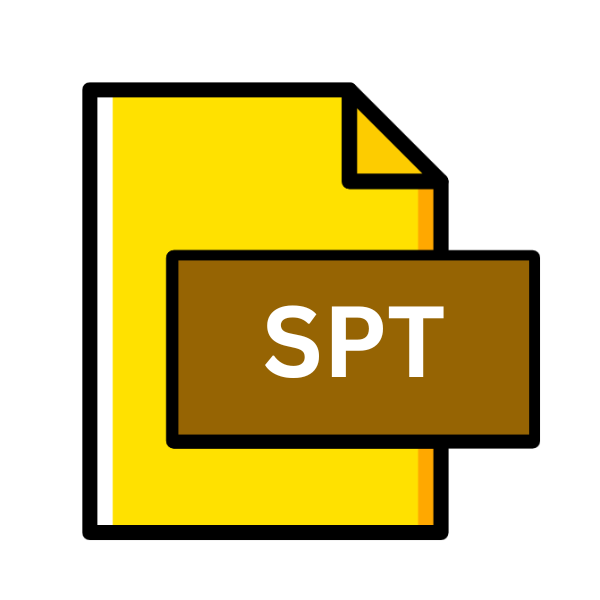.SPT File Extension

ESPL Programming File
| Developer | Ensign Software |
| Popularity | |
| Category | Developer Files |
| Format | .SPT |
| Cross Platform | Update Soon |
What is an SPT file?
In the vast digital landscape of programming, various file extensions play pivotal roles in encapsulating code, configurations, and data.
Among these, the .SPT file extension stands out as a significant entity, particularly in the realm of ESPL programming.
This article embarks on a journey to unravel the intricacies of .SPT files, exploring their origin, evolution, technical specifications, advantages, disadvantages, and methods for conversion and utilization across different operating systems.
More Information.
The history of .SPT files trace back to the emergence of ESPL as a prominent programming language for embedded systems.
Initially conceived as a means to streamline the development process for embedded systems, .SPT files served as containers for ESPL code snippets, configurations, and project data.
Their primary purpose was to facilitate seamless integration and deployment of ESPL programs onto various embedded platforms.
Origin Of This File.
The .SPT file extension finds its roots intertwined with ESPL (Embedded Systems Programming Language). ESPL is a specialized language tailored for programming embedded systems.
It demanded a dedicated file format to encapsulate its code and configurations effectively. Thus, the .SPT file extension emerged as the standard bearer for ESPL programming files.
File Structure Technical Specification.
At its core, a .SPT file is a structured document that contains ESPL code, configurations, and metadata. The technical specifications of .SPT files typically adhere to the standards defined by ESPL programming environments.
The structure may vary depending on the specific requirements of the embedded system and the toolchain used for ESPL development. A typical .SPT file comprises the following components:
- Header: Contains metadata such as file version, creation date, and author information.
- ESPL Code: The actual ESPL code snippets or scripts, organized into functions, modules, or classes.
- Configurations: Settings and parameters specific to the embedded system, including hardware configurations, communication protocols, and memory allocations.
- Comments and Annotations: Descriptive comments and annotations to enhance code readability and maintainability.
How to Convert the File?
Converting .SPT files to other formats or vice versa may be necessary to facilitate interoperability or integration with non-ESPL environments. Here’s a guide on how to convert .SPT files:
1. Manual Conversion: Manual conversion involves opening the .SPT file in a text editor or IDE compatible with ESPL programming. Once opened, you can copy the code or configurations and paste them into a new file with the desired format. This method is suitable for converting .SPT files to plain text (.TXT) or other text-based formats.
2. Using ESPL Development Tools: Many ESPL development environments provide built-in functionality or plugins for exporting .SPT files to different formats. These tools may offer options to convert .SPT files to executable binaries, firmware images, or project archives compatible with specific embedded systems platforms.
3. Third-Party Conversion Utilities: Various third-party conversion utilities or scripts are available online, offering automated solutions for converting .SPT files to alternative formats. These utilities may support batch processing, custom formatting options, and integration with popular programming languages and platforms.
4. Online Conversion Services: Online conversion services provide web-based tools for converting .SPT files to a wide range of formats accessible via a web browser. Users can upload their .SPT files to the service and select the desired output format, after which the converted files can be downloaded directly from the website.
5. Scripting and Automation: For advanced users or developers familiar with scripting languages such as Python, Perl, or Bash, custom conversion scripts can be created to automate the conversion process. These scripts can parse .SPT files, extract relevant data, and generate output files in the desired format programmatically.
6. IDE or Text Editor Plugins: IDEs and text editors used for ESPL programming may offer plugins or extensions that enhance their functionality, including support for converting .SPT files. These plugins may integrate seamlessly with the IDE’s user interface, providing convenient options for exporting .SPT files to alternative formats.
7. Cross-Platform Compatibility: When converting .SPT files for use across different operating systems or platforms, it’s essential to consider cross-platform compatibility. Choose conversion methods and formats that are supported universally or have equivalent counterparts on target platforms to ensure seamless integration and deployment.
Advantages And Disadvantages.
Advantage:
- Portability: .SPT files offer portability across different ESPL development environments and embedded platforms, ensuring seamless code migration and deployment.
- Compactness: Due to their structured nature, .SPT files tend to be compact, conserving storage space and simplifying version control and distribution.
- Ease of Integration: .SPT files streamline the integration of ESPL code with peripheral libraries, drivers, and system configurations, accelerating the development cycle.
- Platform Independence: .SPT files abstract the underlying hardware complexities, allowing developers to focus on application logic without being tied to specific hardware architectures.
Disadvantage:
- Limited Compatibility: .SPT files may have limited compatibility with non-ESPL environments, necessitating conversion or adaptation for use with other programming languages or platforms.
- Toolchain Dependency: The effective utilization of .SPT files often rely on specific ESPL toolchains and development environments, restricting flexibility and interoperability.
- Debugging Challenges: Debugging ESPL code encapsulated within .SPT files may pose challenges, as real-time debugging capabilities may be limited compared to traditional programming languages.
How to Open SPT?
Open In Windows
In Windows, .SPT files can be opened using a compatible ESPL development environment or text editor.
Additionally, specialized conversion tools or scripts may facilitate conversion to other formats supported by Windows-based programming environments.
Open In Linux
Linux users can leverage ESPL development tools and text editors to open and edit .SPT files seamlessly. Command-line utilities or custom scripts can aid in file conversion or integration with Linux-based development workflows.
Open In MAC
macOS users can utilize text editors or integrated development environments (IDEs) with ESPL support to work with .SPT files.
Third-party conversion utilities or plugins may extend compatibility with macOS-native programming tools and environments.
Open In Android
On Android devices, .SPT files can be accessed and edited using text editors or ESPL-specific mobile development apps available on the Google Play Store.
File conversion utilities may facilitate compatibility with Android programming frameworks or integrated development environments.
Open In IOS
iOS users can explore ESPL programming on their devices using compatible text editors or IDEs available on the App Store.
While iOS imposes certain constraints on file management and execution, .SPT files can still be edited and utilized within the limitations of the iOS ecosystem.
Open in Others
For other operating systems or specialized environments, the approach to opening and converting .SPT files may vary.
The fundamental principles remain consistent, relying on compatible tools, utilities, or development environments tailored to ESPL programming.













